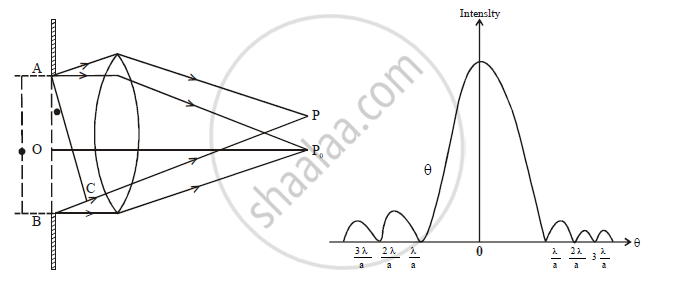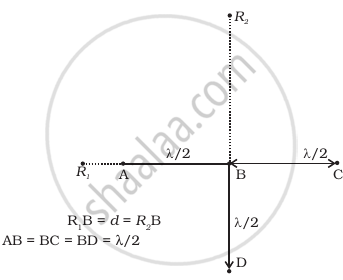Advertisements
Advertisements
Question
Show graphically the intensity distribution in Fraunhofer's single slit diffraction experiment. Label the axes.
Solution
Fraunhofer diffraction due to a single slit: Consider a monochromatic parallel beam of light of the wavelength `lambda` falling on a narrow slit of width `a` as shown in the figure. A diffraction pattern is formed on the screen placed in the focal plane of the convex lens. Let `O` be the centre of the slit and `P_o` be the central
point of the screen. The rays extending from the slit on either side `OP_o` are at equal optical paths from `P_o` The maximum intensity is observed at central point `P_o`. It is called the principal maximum.

As `theta` increases, the intensity changes between alternate minima and maxima.
The condition for minima is `a sin theta = nlambda` where n = 1,2,3,4....
The condition for minima is `a sin theta = (2n + 1)lambda"/"2` where n = 1,2,3,4....
APPEARS IN
RELATED QUESTIONS
A point is situated at 7cm and 7·2 cm from two coherent sources. Find the· nature of illumination at the point if wavelength of light is 4000A.
Explain two types of diffraction of light.
Draw the intensity distribution for the diffraction bands produced due to single slit ?
Which of the following device is used to study the spectra of light?
Consider the diffraction pattern for a small pinhole. As the size of the hole is increased ______.
- the size decreases.
- the intensity increases.
- the size increases.
- the intensity decreases.

AC = CO = D, S1C = S2C = d << D
A small transparent slab containing material of µ = 1.5 is placed along AS2 (Figure). What will be the distance from O of the principal maxima and of the first minima on either side of the principal maxima obtained in the absence of the glass slab?
Four identical monochromatic sources A, B, C, D as shown in the (Figure) produce waves of the same wavelength λ and are coherent. Two receiver R1 and R2 are at great but equal distances from B.
- Which of the two receivers picks up the larger signal?
- Which of the two receivers picks up the larger signal when B is turned off?
- Which of the two receivers picks up the larger signal when D is turned off?
- Which of the two receivers can distinguish which of the sources B or D has been turned off?

Draw the graph showing intensity distribution of fringes with phase angle due to diffraction through a single slit. What is the width of the central maximum in comparison to that of a secondary maximum?
In a diffraction pattern due to a single slit, how will the angular width of the central maximum change, if the screen is moved closer to the slit?
Justify your answer.
In a diffraction pattern due to a single slit, how will the angular width of the central maximum change, if the slit width is decreased?
Justify your answer.
